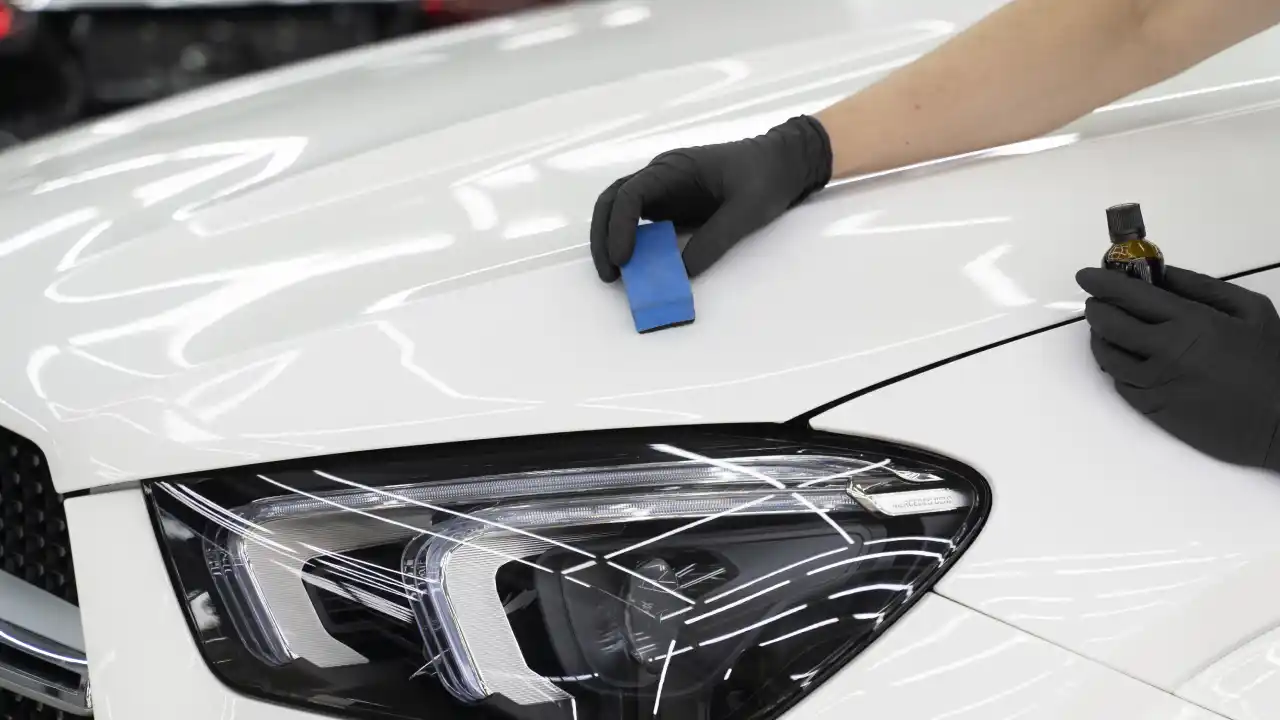Ceramic Coating: Shield Your Lorry from Environmental Threats effortlessly
Ceramic Coating: Shield Your Lorry from Environmental Threats effortlessly
Blog Article
Checking Out the Science Behind Ceramic Finish and Its Effect On Automobile Outlining
The application of ceramic finishing in vehicle describing stands for a substantial advancement in auto care, rooted in its innovative chemical buildings, mostly silica dioxide and titanium dioxide. As we explore the complexities of the application procedure and the long-term implications for automobile upkeep, it ends up being clear that the option of ceramic covering can fundamentally change one's strategy to vehicle treatment.
What Is Ceramic Finish?
Ceramic coating is a contemporary remedy that has gained appeal in the automotive detailing sector for its ability to offer durable protection for automobile surfaces. This advanced protective layer is commonly made up of silica dioxide (SiO2), which creates a solid bond with the automobile's paint, developing a sturdy guard against ecological impurities. Unlike conventional wax or sealers, ceramic layers offer premium resistance to UV rays, chemical spots, and physical abrasions.
The application of ceramic finish involves a thorough process, where the vehicle's surface area is completely cleaned up and sanitized prior to the layer is applied (Ceramic Coating). As soon as cured, the coating improves the lorry's gloss, depth, and clearness, supplying a showroom-quality coating that lasts for years. One of the crucial benefits of ceramic coating is its hydrophobic properties, which drive away water and dust, making upkeep less complicated and decreasing the frequency of laundries
The Chemistry of Ceramic Finish
A fundamental aspect of ceramic finishing lies in its chemical structure, mostly defined by the existence of silica dioxide (SiO2) This compound is essential to the formation of a long lasting, protective layer that bonds chemically to the car's surface.
Along with SiO2, numerous ceramic coatings incorporate titanium dioxide (TiO2) and various other ingredients to improve their performance characteristics. TiO2, for example, adds to boosted firmness and chemical resistance. The interaction between these substances develops an one-of-a-kind molecular framework that provides a high level of defense against environmental factors such as UV rays, acid rainfall, and oxidation.
Moreover, the application process typically includes a precise preparation of the surface area to ensure ideal attachment of the finish. This chemistry not only makes sure a durable surface but likewise improves the aesthetic allure of the lorry. Comprehending the intricate chemistry behind ceramic coatings is necessary for detailing specialists who intend to provide remarkable protection and durability for their customers' automobiles.
Advantages of Ceramic Finishing
While describing professionals typically highlight the advantages of ceramic finishes, their advantages extend far past aesthetics. Ceramic coverings produce a hydrophobic surface that pushes back grime, water, and dirt, significantly reducing the frequency of cleans and the initiative called for to keep a lorry's look.
Additionally, ceramic finishes boost the long life of the lorry's surface. Unlike standard waxes or sealants, which may last a few months, ceramic coatings can sustain for several years, giving a long-lasting service for automobile care. This resilience translates to set you back financial savings, as owners are less most likely to require frequent reapplication.
Additionally, ceramic layers visit site are immune to chemical discolorations and etching, which can happen from acidic compounds like bird droppings or tree sap. This resistance not only maintains the lorry's looks however also minimizes possible damages - Ceramic Coating. In general, the investment in ceramic covering offers auto owners a significant return in regards to security, ease of upkeep, and lasting aesthetic allure, making it a progressively preferred option in the world of auto outlining
Application Process Explained

As soon as the surface area is appropriately prepared, the ceramic layer can be used. It is normally carried out in a regulated atmosphere, such as a garage or detailing bay, to stop contamination from dirt and particles. Utilizing an applicator pad, the service technician applies the covering in small areas, functioning in a crosshatch pattern to make sure even protection. It is vital to follow the manufacturer's guidelines relating to application thickness and curing times.
When treated, the ceramic coating develops a solid bond with the paint, supplying improved protection and a shiny coating. Correct application is crucial to make the most of the longevity and efficiency of the ceramic finishing.

Lasting Impact on Lorry Treatment
The long-term impact of ceramic coating on lorry treatment is significant, as it fundamentally modifies how proprietors keep their automobiles. By producing a durable, hydrophobic layer on the car's surface, ceramic finishings decrease the adherence of dust, grime, and contaminants. This residential property minimizes the frequency of cleaning called for, eventually saving water and cleaning products.
Furthermore, the UV protection provided by ceramic finishes aids to avoid oxidation and fading of the car's paint, preserving its visual charm and resale value with time - Ceramic Coating. This protective barrier additionally lowers the likelihood of scrapes and swirl marks, which prevail issues in conventional paint coatings
Moreover, ceramic finishings assist in simpler maintenance, allowing proprietors to clean their cars with marginal initiative. The smooth surface area makes it hard for pollutants to bond, allowing easier elimination throughout routine cleaning.
Over time, the investment in ceramic coating may cause set you back financial savings in car treatment services and products. On the whole, the withstanding advantages of ceramic layers not only boost the look of lorries yet also contribute to an extra sustainable and effective approach to automobile maintenance.
Final Thought
To conclude, the application of ceramic coating stands for a considerable advancement in car More Bonuses outlining, driven by its unique chemical make-up of silica dioxide and titanium dioxide. This innovation not only boosts the visual appeal of automobiles yet also supplies robust defense against ecological threats and put on. The official statement long-lasting benefits, including minimized maintenance regularity and enhanced resilience, emphasize the worth of ceramic coatings as an important investment for preserving automobile look and honesty over time.

Report this page